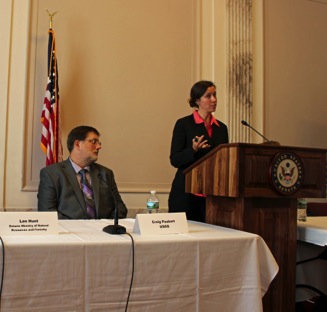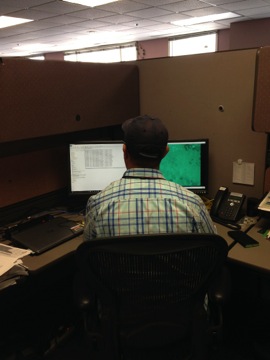Be in the know, now back on the grind
Add Summary

July 15, 2016
Janet Hsiao is a master's degree student studying how landscape characteristics may affect the quality and condition of coastal habitats and the organisms they support. She is advised by Dana Infante.
Over the past few weeks, I have grown from a perpetually disheveled data scientist and learned to dress slightly better than a sack of potatoes –an added benefit of my summer of experiential learning in the DC area.
I was graciously hosted by my guidance committee member, Dr. Abigail Lynch, at the U.S. Geological Survey National Climate Change and Wildlife Science Center. My thesis investigates how terrestrial landscape characteristics may affect the quality and condition of coastal habitats and the organisms they support. Thanks to this exposure, I return to Michigan with added perspective on the broader relevance of my graduate research.
landscape characteristics may affect the quality and condition of coastal habitats and the organisms they support. Thanks to this exposure, I return to Michigan with added perspective on the broader relevance of my graduate research.
The first week of my stay coincided with the Capitol Hill Ocean Week, where I immediately felt the strong contingency of Michigan State University alumni when I ran into Chiara Zuccarino-Crowe. Chiara was organizing panelists at the time, but we subsequently met when I visited the National Oceanic and Atmospheric Administration (NOAA) office in Silver Spring – where she works at the Office of National Marine Sanctuaries. Chiara showed me around and taught me about the role that her agency plays in informing the public.
Did you know that if you harass seals in a sanctuary designation, you are breaking two laws (Marine Mammal Protection Act and Marine Mammal Protection Act) concurrently? These are codes grounded in science, where studies recognized that human intervention alters animal natural behaviors. The legislation then gets translated to regulations on the ground once it is in place.
During the same trip to NOAA, I had an opportunity to say hello to other friends of the MSU Fisheries & Wildlife Department past. This included visiting Dr. Trevor Meckley and Eric MacMillan to learn about their works in supporting and enabling federal research.
I also witnessed Dr. Ayman Mabrouk process video recordings from a remotely operated underwater vehicle – seeing data collection first hand as he quantifies benthic habitat types. Upon mentioning my interest in understanding inland-coastal linkages, I was quickly escorted around the building to meet others studying similar themes. After several iterations of handshaking and summarizing my research (nailing that elevator speech), I was informed about current efforts in understanding human influences on the coast and identified an upcoming resource that can supplement my research. I have bookmarked the page and will be meticulously checking back for the soon-to-be release of the Marine Biogeographic Assessment of the Main Hawaiian Islands! Overall, I am impressed by everyone’s respective expertise, how open they are to conversations, and am grateful to be a part of this supportive network of kind people.
recordings from a remotely operated underwater vehicle – seeing data collection first hand as he quantifies benthic habitat types. Upon mentioning my interest in understanding inland-coastal linkages, I was quickly escorted around the building to meet others studying similar themes. After several iterations of handshaking and summarizing my research (nailing that elevator speech), I was informed about current efforts in understanding human influences on the coast and identified an upcoming resource that can supplement my research. I have bookmarked the page and will be meticulously checking back for the soon-to-be release of the Marine Biogeographic Assessment of the Main Hawaiian Islands! Overall, I am impressed by everyone’s respective expertise, how open they are to conversations, and am grateful to be a part of this supportive network of kind people.
Another highlight of my DC experience is attending two congressional briefings that showcased the intersectionality between science and



 Print
Print Email
Email





